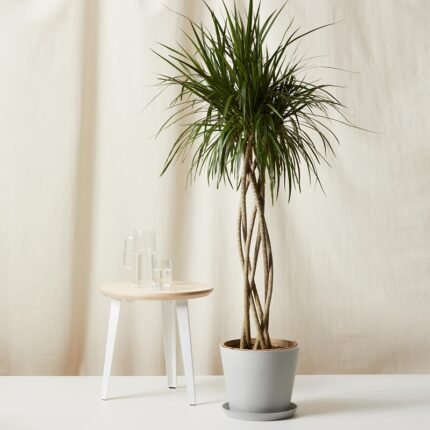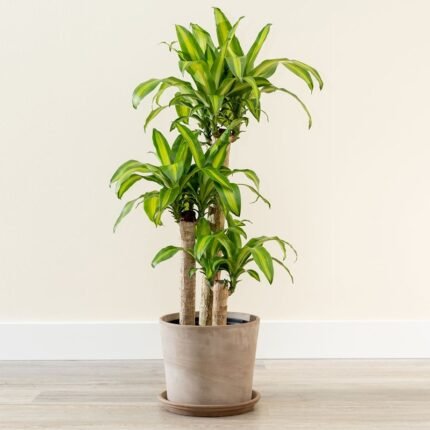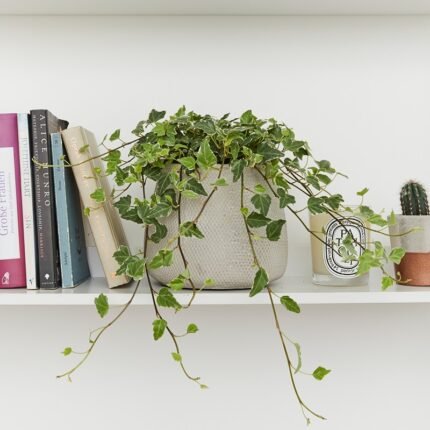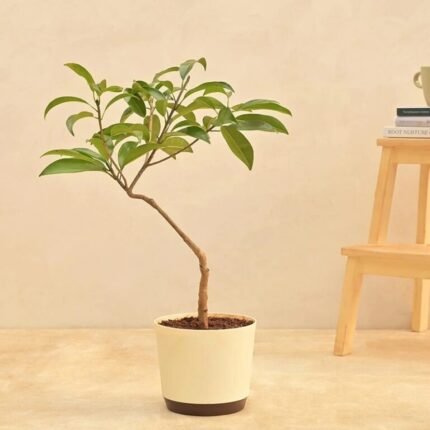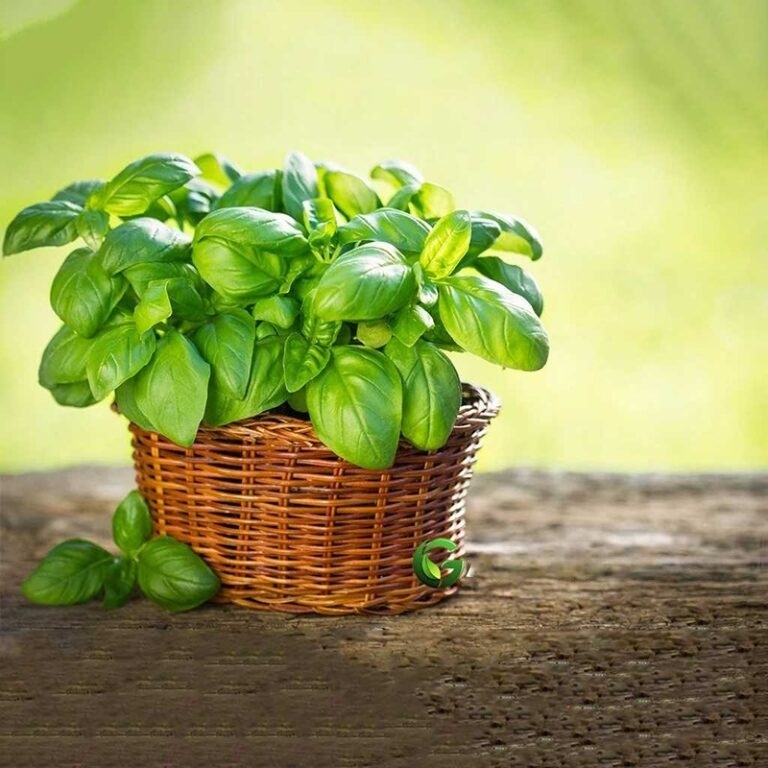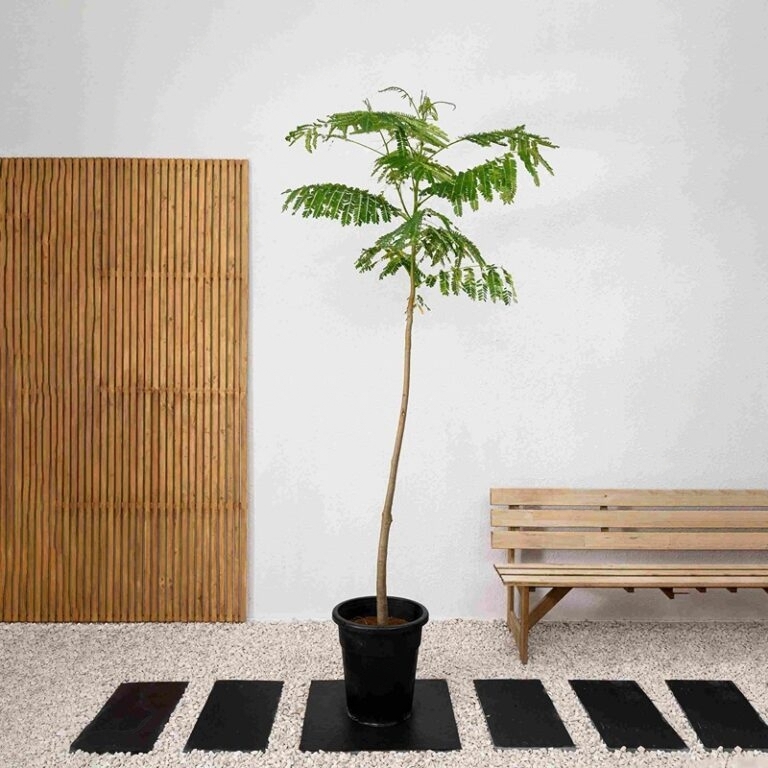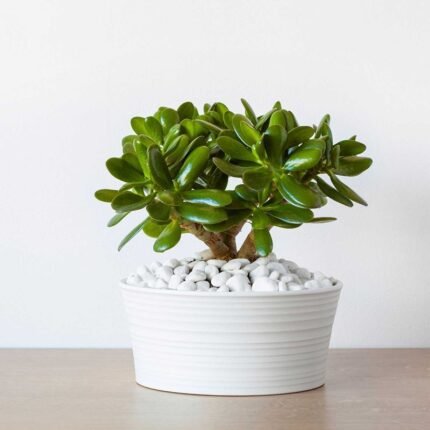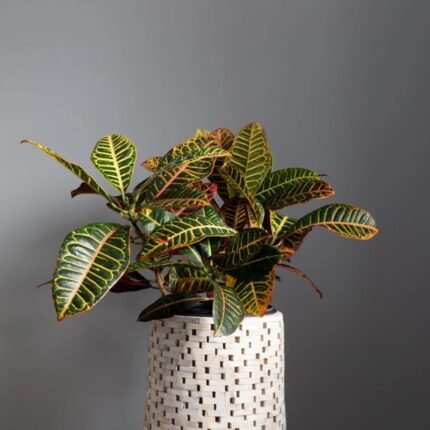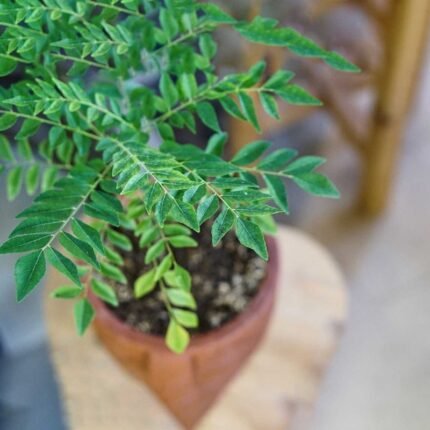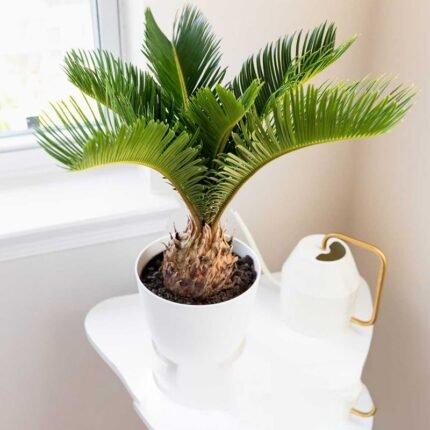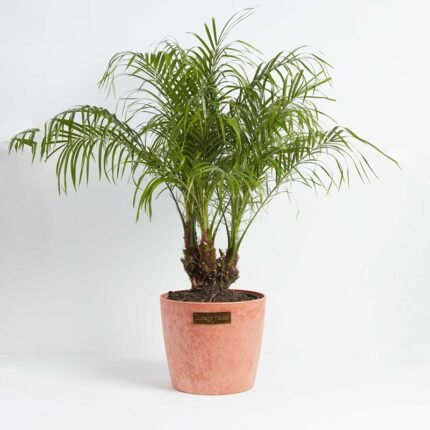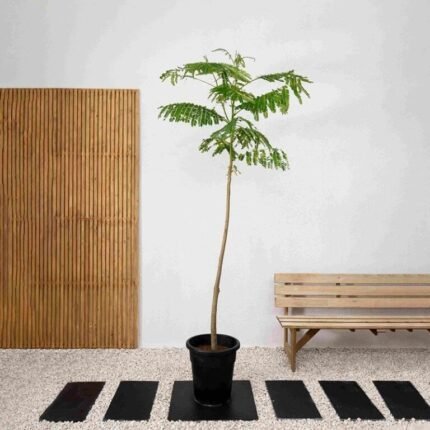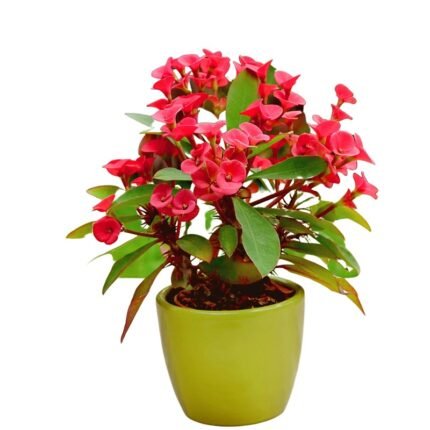DRACAENA MARGINATA – DRAGON TREE
Dracaena marginata, more commonly known as a dragon tree, is an attractive plant with green sword-like, red-edged leaves. Native to Madagascar, the eye-catching spiky tree is known as a great entry plant for household gardeners—it’s easy to care for, drought-tolerant, and nearly indestructible. The slow-growing plant can be planted year-round and boasts tiny white flowers in the spring (though it rarely flowers indoors). This small tree will grow to about 20 feet in warm outdoor climates, but it is generally grown as a potted houseplant and kept pruned to 6 feet or less.
DRACAENA MASSANGEANA
Dracaena Massangeana is also called the Happy Plant because of the simple nature of this plant. It helps to filter out toxic air inside homes and offices. Dracaena Massangeana needs moderate to bright indirect light and is ideal for offices or fluorescent lighting. Avoid direct sunlight as this may burn or bleach the leaves. Water when the soil starts to dry-out at the top. Water well and allow to drain thoroughly. Relatively drought tolerant. Do not overwater as this will cause the leaf tips to blacken. Dracaena are hardy houseplants and will do well in normal room humidity, however they do prefer higher humidity and will benefit from occasional misting.
ENGLISH IVY
English ivy (Hedera helix) is an evergreen perennial. It is also classified as a woody vine. English ivy can act as a ground cover, spreading horizontally. But it is also a climber, due to its aerial rootlets, which allows it to climb to 80 feet high. The plant will eventually bear insignificant greenish flowers, but it is grown primarily for its evergreen leaves. In this regard, ivy can be classified as a foliage plant. The best time to plant English ivy is spring. It is a fast, aggressive grower that is considered invasive in many areas. Keep a watchful eye on children and pets because English ivy is toxic to humans and animals.
CHIKOO – SAPODILLA
CHIKOO – SAPODILLA
Manilkara Zapota commonly known as Chikoo trees are long-living evergreen trees. These are cultivated for their edible sweet fruits. With its native origin to Central America, Mexico & West Indies, but find its a wide distribution throughout Southeast Asian countries. Chikoo trees have a tendency to grow about 5 – 20 m tall when cultivated in your home garden. This tree consists of glossy medium green leaves, which are alternate, and elliptic to ovate with an entire margin. Manilkara Zapota also blooms inconspicuously with white flowers, that are bell-like, with a six-lobed corolla. The fruit that it bears is somewhat like a large berry (4 – 8 cm in diameter) with its color turning from a pale yellow to an earthy brown as it gets ripened. With their attractive appearance and easy-to-care conditions, these trees are excellent for ground cover or other relevant ornamental purposes.
CRASSULA OVATA – JADE PLANT
The jade plant is a popular succulent houseplant with simple indoor/outdoor care requirements and a very long lifespan of up to 70 years with the proper care. This plant is slow-growing—gaining only about two inches of height per year, but it can reach a total height between three and six feet. Jade plants feature thick, woody stems topped by green, fleshy leaves with an oval shape. Plant in loose, well-draining soil. A succulent potting mix is the best option.
CROTON PLANT
The croton plant (Codiaeum variegatum) has colorful variegated foliage and nearly limitless leaf forms with hundreds of croton plant varieties. Croton plants grow best outdoors in warm, humid climates. They like full to dappled light and plentiful water. Growing croton plants indoors can be a challenge to mimic their ideal conditions. Outdoor croton plants can reach around 8 feet tall, but as pot-grown houseplants they tend to be much smaller, making Croton a good indoor plant in that regard. In general, Codiaeum variegatum grows relatively slowly, gaining less than a foot per growing season.
CURRY LEAVES PLANT
Native to India, the fast-growing curry tree is a small evergreen bush or tree that can reach anywhere from six to 20 feet tall. The most widely known part of the curry tree is its aromatic, spicy foliage, comprised of many leaflets. The leaves are pinnate and form alternately on the stem. They are best harvested when fresh. The tree produces fragrant white flowers, which develop into small, black fruits similar to berries. Unlike the leaves, they are not suitable for consumption. The curry tree is best planted in the spring.
CYCAS PALM – SAGO PALM
Despite its common name, sago palm (Cycas revoluta) isn’t technically a true palm tree though it may have the appearance of other types of palm. Sago palm grows best in warm, humid conditions, and requires four to six hours daily of dappled sunlight, acidic soil, and consistent temperatures between 18 and 23 degrees Celsius. These fairly low-growing plants with long green fronds are cycads, a group of ancient tropical and subtropical plants that usually grow from a trunk that doesn’t branch out; it produces nuts but doesn’t flower or fruit. Sago palms are native to warm parts of Japan and southern China.
DATE PALM
The date palm (Phoenix dactylifera) has a commanding presence. Its arching, gray-green, waxy fronds can reach more than 10 feet long, forming a stately crown at the top of the tree. Panicles of pale yellow flowers generally appear in the spring. And they give way to the edible oblong fruits (the dates) that begin as green and then typically turn brown as they ripen. The palm is slow-growing, gaining a few feet per year on average. It can be planted in the spring or fall.
DELONIX TREE
Delonix regia or Flame Tree is a semi-evergreen tree (fully deciduous in areas with a long, dry season). It has a wide-spreading, dome-shaped crown and broadly ovate, 2-pinnate, bright green leaves, 30-50cm long, each pinna divided into 10-25 pairs of elliptic to oblong leaflets. From spring to summer, bears many scarlet flowers, 10-13cm across, the standard petals pale yellow and striped with red. Height to 10m, Spread 5-10m. Native of Madagascar. During summer, Water daily or when the soil starts to become slightly dry at the top. During the Winter season water once in 2 days or when the soil starts to become slightly dry at the top. Keep the soil lightly moist at all times, but do not overwater as this will cause brown spots and leaf drop.
EUPHORBIA
The Euphorbia genus includes annual, perennial, and biennial species. You’ll find herbaceous plants and woody shrub species as well as both deciduous and evergreen species. The linking characteristic among the species is the presence of a milky white sap in the plants which comes out of the plants when cut or damaged. This white poisonous sap is something that deer and rabbits don’t like and is highly toxic and an irritant to the skin and eyes.
FICUS AMSTEL QUEEN
This Ficus variety has long, banana-shaped leaves. The large, leathery, fast-growing foliage has a lush tropical appeal. This plant has similar growth habits to Ficus Alli, but has many wider, thicker and somewhat larger leaves. During active growth periods, growth tips are a very pronounced pink to red that contrasts beautifully against the broad, shiny leaves. ‘Amstel Queen’ holds its foliage extremely well indoors as well as outdoors.






